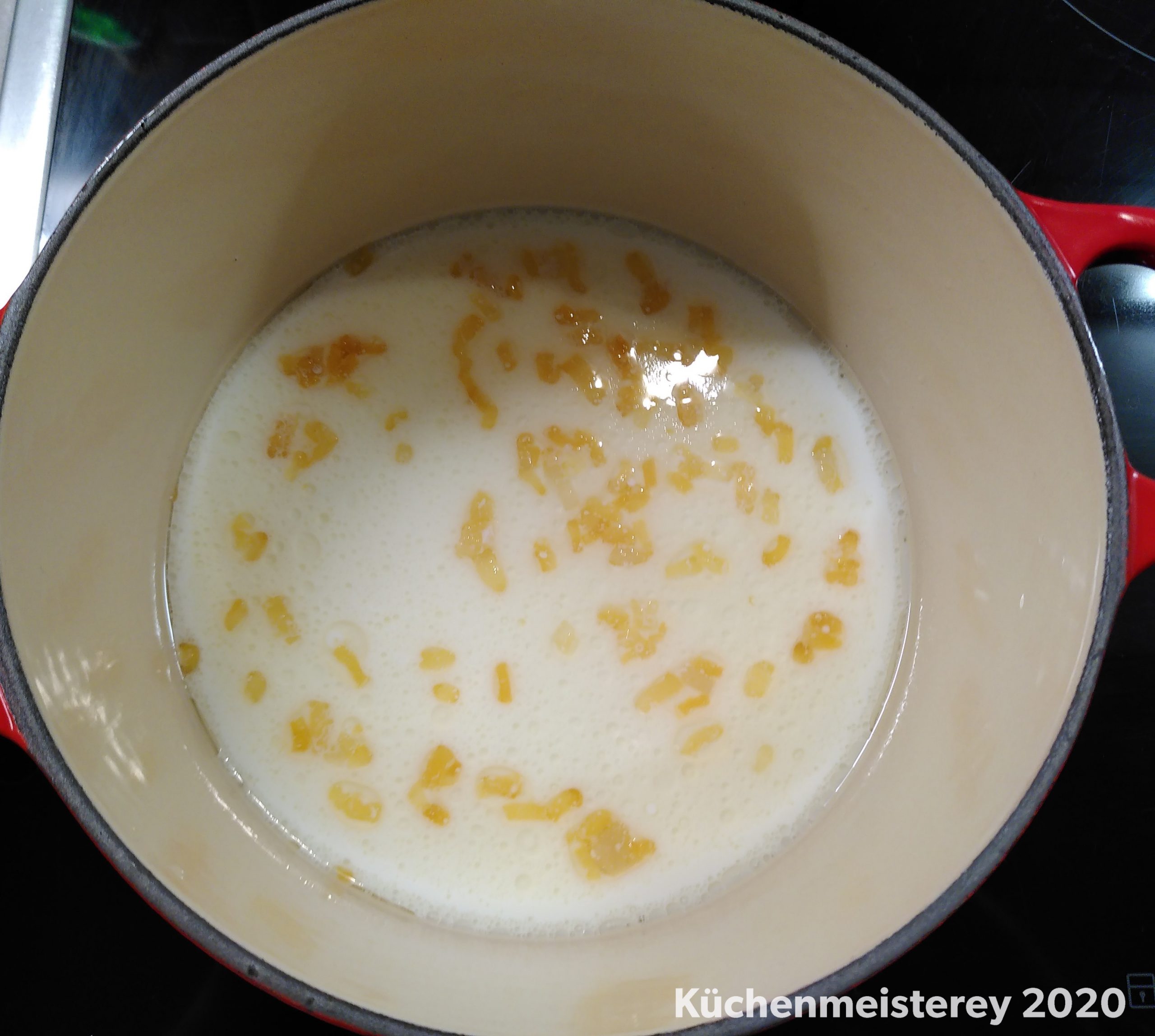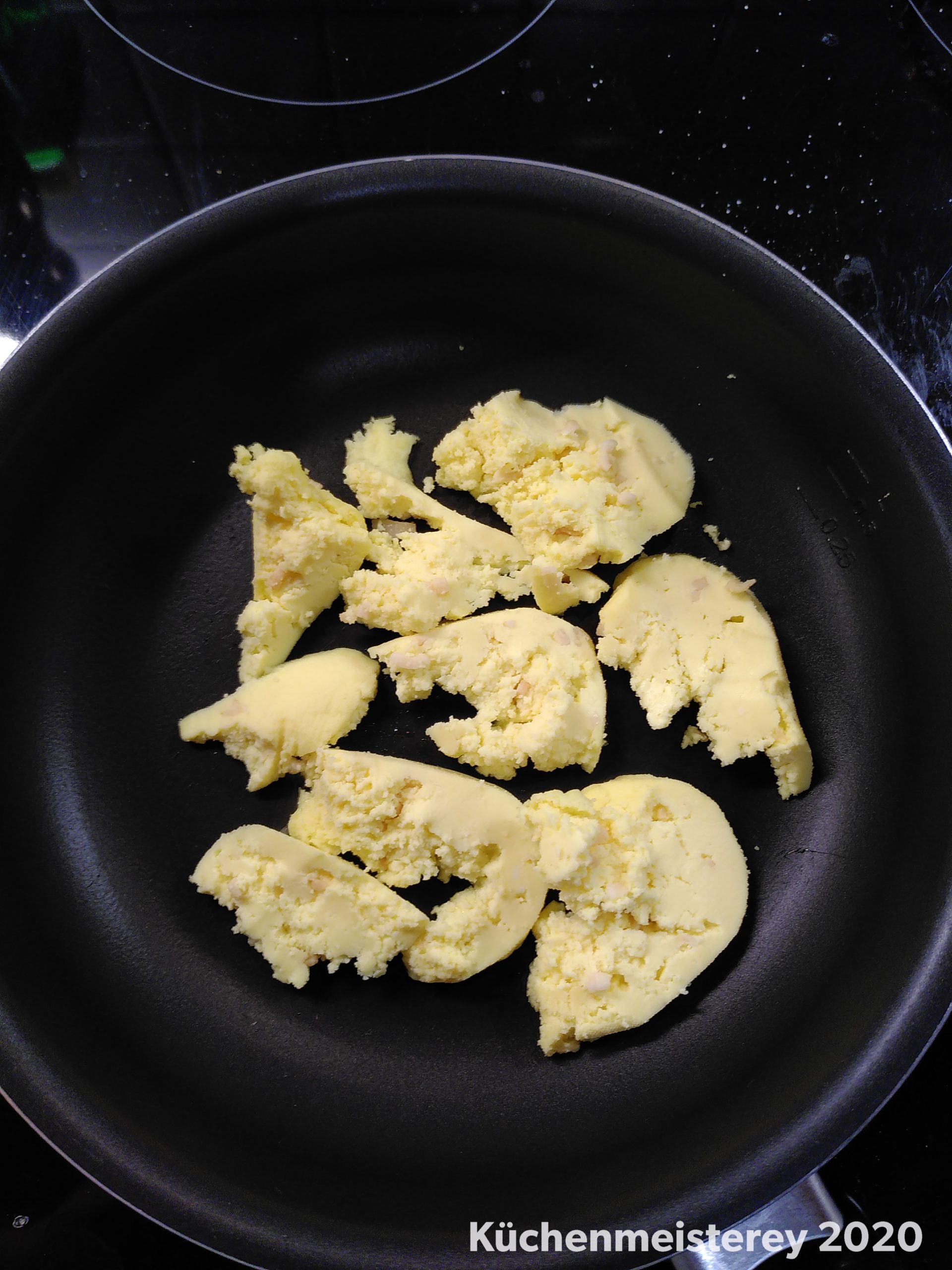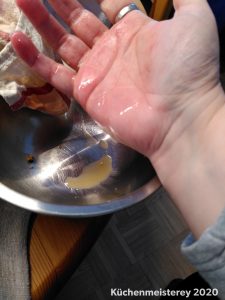
Christa Schwab’s period of representation lies in the 12th century. Therefore she is especially fascinated by the early and high medieval cuisine.
The more imprecise and unusual the recipe, the less it lets her go. Therefore, a large part of Christa’s medieval cooking consists of experiments.
Her second research focus is on Persian-Arabic cuisine and the strong influence it has had on European cuisine since the High Middle Ages.
https://friedrich-und-hildegard.at/
recipes from ‘Libellus de arte coquinaria’ (12th/13th century):
Grewe, Rudolf (Ed.), Constance Hieatt – „Libellus De Arte Coquinaria: An early Northern Cookery Book“ Medieval and Renaissance Texts and Studies, Bd. 222, Arizons Center for Medieval and Renaissance Studies, 2001.
The “Libellus de arte coquinaria” is considered to be the oldest surviving cookery book from the North-West European region. The oldest version of the manuscript was written in Denmark, but contains texts that suggest a North German origin. It is also the only cookbook of this period that was not written in Latin but in various North European languages and dialects.
Walnut Oil (How to make walnut oil)
(Original from manuscript K – oldest, preserved version):
Man skal takæ en dysk mæth nutæ kyærnæ, oc en æggy skalæ full mæth salt, oc latæ them samæn i en heet mortel oc stampæ thæt wæl, oc writhæ gømæn et klæthæ; tha warthær thæt oly.
(Transfer from the complete translation of all manuscripts):
Take a dish of walnut kernels and an eggshell full of salt and grind them together in a heated mortar, then wring this through a cloth. It becomes oil.
Implementation:
Notes:
THE cooking fats in the Middle Ages were (depending on the area) olive oil, butter (also clarified butter) and lard.
However, nut oils are also frequently mentioned for this purpose, of which almond oil is the most prominent. This development is certainly also due to the influence from Arabic cuisine or medicine, with which the use of nuts and nut products – especially almonds – is also increasing in Europe.
It should be noted that these nut oils cannot be heated to a high temperature before they burn – they were therefore not used for frying or deep-frying but rather for baking or refining dishes (e.g. various paps or desserts).
My aim in implementing the above recipe was to find out whether walnut oil can actually be extracted from a small quantity of nuts or whether a large quantity is needed to get a result at all. So how much oil is in such a walnut and how difficult is it to extract the oil?
As I am reluctant to throw away food, I have from the beginning decided to process the press cake into walnut marzipan. So I replaced the salt in the recipe with sugar. Both are used mainly as grating material to make the crushing easier.
Salt – also fine salt – was certainly more readily available than sugar in Northern Europe at the end of the 12th century. Salt would therefore certainly be the historically more correct ingredient at this point.
In addition, a salty version of the oil can be used in a more versatile way.
It would be interesting to have the opportunity to test which additive would keep the oil edible longer…
By the way, I suppose that even in the Middle Ages people did not throw away the press cake. In medieval cookery book literature, there are a whole range of applications for mortared nuts, even if they are partially oiled – for example, thickening sauces or as an additive for soups or pâté fillings. These recipes mostly call almonds (probably because of the less dominant flavour) but where it fits, you can certainly use walnuts.
Ingredients:
- Walnuts
- Sugar
(Note on nuts: Small nuts from old trees are generally more aromatic than the large cultures available in supermarkets today. If you only have large nuts available, I advise you to roast the nuts lightly and process them warm – this enhances the aroma.)
Preparation:
Heating the mortar:
The heated mortar warms the nuts during crushing and ensures that the oil can be extracted more easily.
As I do not have a large stone mortar, I have used my small, modern granite mortar. I heated the mortar in the oven at 80 – 130 degrees until it just felt hot.
Caution: Heating a stone mortar can cause the stone to burst. Therefore it is essential to start with a low temperature and heat it up slowly until it feels hot but can still be touched.
I have then wrapped the mortar in a linen cloth to make it easier to hold on to.
Add nuts and sugar and pestle them very thoroughly.
It is absolutely necessary to grind the nuts as finely as possible. The finer the nut is chopped, the better the oil can be obtained.
You will soon notice that the nut mass feels increasingly oily and shines more and more the longer you work it.
Pour the nut mixture into a linen cloth and squeeze it firmly.
This step was particularly exciting. Of course it was clear that the mass would be greasy – nuts contain oil – but will it be enough that the cloth will not simply absorb everything?
 And as you can see, the process was successful. The mass was far enough oily to release a noticeable amount of oil even from a small initial quantity of nuts.
And as you can see, the process was successful. The mass was far enough oily to release a noticeable amount of oil even from a small initial quantity of nuts.
So if you take a larger quantity of nuts and add a pressing device that is stronger than my hand (such as a stone or a bowl filled with water, to name the simplest options), you can assume that extracting walnut oil will not have been too much trouble.
Milk with Bacon (Larded Milk)
(Original from manuscript Q – oldest, preserved version):
Mæn sculæ takæ søøt mialk oc latæ thær i slaghæn æg, oc latæ thær til flæsk scoræth æm storth æssæ tærning, oc latæ thær i stampæth bark safran oc latæ alt samæn wællæ, oc sættæ thæt sithæn up. Oc latæ thæt cølæs oc hylæ thæt wæl mæthæn thæt cølæs, oc tæ sithæn sighæ af alt thæt watnæ thæri ær; thuingæ thæt i eth klæthæ at alt løpær af thæt thær watn ær. Oc skæræ thæt thær æftær ær i skivæ, oc læggæ thunnæ spanæ up a en rist, oc stekæ thæt thær a. Thæt hetær spæckæt mialk.
(Transfer from the complete translation of all manuscripts):
Take fresh milk, and to it add beaten egg, diced pork, and ground saffron, and let this all simmer together. Then take it up and let it cool, and cover it well while it cools. Let all the water in it drain off, and squeeze it in a cloth so that this water runs off. After doing this, cut it into slices and put thin slices on a gridiron and broil it there. This is called „Larded Milk.“
Implementation:
Notes:
This is a rather strange recipe when you read it for the first time.
Obviously, the aim is to create a sliceable mass at the end, which also holds together on a grill during roasting. And that alone with egg, milk and rendered fat.
My first thought was to make a very firm egg cream. That means to boil down so much egg that it stands by itself. But in this case, draining and pressing makes no sense. If you tried to press the egg cream (however hard it is), all that would be left would be … well, crushed egg cream – at least nothing you could cut and fry on a grill.
But now this recipe – almost identical – appears 200 or 250 years later in the Menagier de Paris or in the very late additions to the Viandier de Taillevent.
In both writings it is pointed out that on fast days, one component can be replaced by an acid – in the Viandier the bacon by vinegar, in the Menagier the eggs by verjus.
This at least already indicates what one wants to achieve: the milk should curdle and the whole thing should be processed like a fresh cheese (similar to paneer).
However … the instructions in the Viandier do not make sense – replacing the fat would make no difference.
The eggs in the Menagerie, however – this is actually very reasonable. There is also an explicit instruction NOT to stir when boiling the whole thing. If one would stir, one would create an emulsion, i.e. egg cream. But obviously that is not what we want here.
The eggs are supposed to clot – but that’s not what people are used to nowadays in such a context. Today, if the eggs flocculate in such a mixture, the whole thing is thrown away as a failure, because normally you want a smooth, silky mass.
The whole process goes against everything I’ve learned and against every bit of cooking instinct.
But … the Libellus de arte coquinaria has already surprised me once. I used to make the ‘almond butter’ from the same book and even then I couldn’t imagine that it could work. But it did. (By the way, despite some cooking experience and a lot of reading, I still don’t know why …)
So I decided to trust the Libellus once again and simply followed the instructions.
Ingredients:
- 2 large eggs
- 250 ml milk
- 15 – 20 g pure fat bacon (also called ‘Lard Bacon’ or ‘White Bacon’ – available from the butcher on request)
- 3 – 4 threads of saffron (soaked in a little warm water)
- salt
Preparation:
Put the bacon in a small pot and render it very slowly. I assume that the colour should be uniformly golden at the end (that’s what the saffron is for), so browning the bacon is not desired. But of course it will still take on a little colour.
 Add the milk and bring everything to the boil.
Add the milk and bring everything to the boil.
 Beat the eggs very thoroughly and then stir into the boiling milk. I stirred here (despite the recipe in the Menagerie) because I wanted a “break” as small as possible.
Beat the eggs very thoroughly and then stir into the boiling milk. I stirred here (despite the recipe in the Menagerie) because I wanted a “break” as small as possible.
You can see very well on the picture below that the whole thing flocculates out nice and even.
 Rinse off the saffron water and add to the mixture.
Rinse off the saffron water and add to the mixture.
Place a sieve in a bowl and place a clean cloth in the sieve.
Pour the mixture into the cloth.
 Drain everything for a while and let it cool down. Now the whole thing is already much firmer and has about the consistency of a firmer omelette.
Drain everything for a while and let it cool down. Now the whole thing is already much firmer and has about the consistency of a firmer omelette.
 Carefully squeeze out the mass with the help of the cloth and then screw it firmly into the cloth so that further pressure is created. Put everything in a cool place for a few hours and let it drip off further.
Carefully squeeze out the mass with the help of the cloth and then screw it firmly into the cloth so that further pressure is created. Put everything in a cool place for a few hours and let it drip off further.
Afterwards, something has collected in the bowl that could actually be considered whey with fat deposits. (And no, the milk has not turned sour – so it is definitely not flocculated sour milk, although it looks a bit like that).
 The mass itself responded surprisingly well to the pressure.
The mass itself responded surprisingly well to the pressure.
Unfortunately, I have no way of pressing it evenly, as you would do for cheese or tofu. With an appropriate mould you would probably get a result that you could actually knock out of the cloth in a block.
You can clearly see that in my case the structure of the cloth kept part of the mass dry but crumbly.
The rest, however, actually has the consistency of pressed cream cheese and can be cut easily.
As I worked in my modern kitchen, there is no grill grid on which I could have fried the milk mass, so I used a normal pan.
The mass can also be fried without any problems and does not become soft or crumbly.
 The Libellus de arte coquinaria does not mention how the dish is eaten. The recipe does not even mention salt (which is not unusual in medieval recipes – salt is often taken for granted).
The Libellus de arte coquinaria does not mention how the dish is eaten. The recipe does not even mention salt (which is not unusual in medieval recipes – salt is often taken for granted).
In the following recipe it is pointed out that you can – if you like – also wrap the mixture in a dough and bake it.
We simply ate the whole thing lightly salted, which tastes good.
In the later version (manuscript W) of the Libellus, cinnamon is mentioned as another spice.
I could also imagine that it can be eaten very sweetly with a little honey drizzled over it.
recipes from ‘Anonymous Andalusian Cook Book’ (13th century):
Perry, Charles (Ed. Transl.) „An Anonymous Andalusian Cookbook of the 13th Century.“ -> Link
The so-called “Anonymous Andalusian Cookbook” is actually called “Kitab al tabij fi-l-Maghrib wa-l-Andalus fi ‘asr al-Muwahhidin, li-mu’allif mayhul (or majhul)” – “The Cookbook for Maghreb and Andalusia in the Age of the Almohads, by an unknown author”.
It is therefore one of the works from the Arabic region or Arab-influenced Spain. With the Crusades, Arabic cuisine began to influence European cuisine more and more. In the High Middle Ages a glance into this culinary direction is therefore indispensable.
Medjoul-Dates filled with Walnut Marzipan:
Fruit Made of Sugar
Add one part of sieved sugar to one part of cleaned and pound almonds. Knead it all with rose water and roll your hand in almond oil and make with it whatever you want of all fruits and shapes, if God wishes.
Notes:
Early forms of marzipan have been around in Europe since ancient times.
In the early Middle Ages the trace is lost but then marzipan is found in the Persian-Arabic region. In the 10th century several recipes were written down in Baghdad. Subsequently, in the 13th century, the confectionery appeared in today’s Syria and in Moorish influenced Spain.
Further north, it remained a purely medicinal recipe for a long time, until it was finally perceived and produced again as a sweet in the late Middle Ages and the early Renaissance.
(So no, the marzipan was not invented in Lübeck, I’m afraid …)I have chosen the above recipe because it represents the basic form of marzipan.
Here, almonds are used – just like for today’s marzipan. In other recipes, for example from the 10th century, other nuts are also used, for example pistachios or coconuts.
Walnut marzipan is also mentioned several times, but it was mainly used as a filling for desserts.
In Arabic cuisine, walnuts are very often paired with almonds, because according to the 4-juice doctrine, the walnut has or promotes hot properties and the almond cools. The nuts therefore balance each other out. I have followed this principle with my walnut marzipan and have added ground almonds.
Since walnut marzipan was usually used as a filling, I decided to fill large Medjoul dates with it.
Implementation:
Ingredients:
- 50 g Walnuts (Both peeled and unpeeled walnuts have been used, but shelled walnuts are often advised because they are more digestible).
- 50 g Mandeln (peeled)
- Rose water as you wish
- 100 g Sugar (I have used brown raw cane sugar. The Arab Middle Ages knew many forms of sugar in the kitchen, from molasses to fine, white icing sugar).
- Medjoul-Dates
Preparation:
Mortar both types of nuts and the sugar if necessary (the finer the better).
Knead everything and season with rose water.
Cut the dates open lengthwise on one side and remove the seeds.
Fill the dates with marzipan.
 The marzipan paste can be kept for several weeks without any problems due to the high amount of sugar – as long as it is stored in a cool, dry and dark place.
The marzipan paste can be kept for several weeks without any problems due to the high amount of sugar – as long as it is stored in a cool, dry and dark place.
The marzipan even benefits from “maturing” for several days before eating it because the aromas develop.
Especially the almonds can still absorb a lot of liquid, so the marzipan will feel a little dry – you can simply add a little water to make it supple again.











